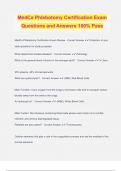Exam (elaborations)
Global Climate Change Turning Knowledge Into Action 1st Edition By David Kitchen (Instructor Manual)
Course
Global Climate Change Turning Knowledge Into Actio
Institution
Global Climate Change Turning Knowledge Into Actio
Global Climate Change Turning Knowledge Into Action 1e David Kitchen (Instructor Manual)
Global Climate Change Turning Knowledge Into Action 1e David Kitchen (Instructor Manual)
[Show more]
Preview 4 out of 105 pages
Uploaded on
June 17, 2023
Number of pages
105
Written in
2022/2023
Type
Exam (elaborations)
Contains
Questions & answers
Institution
Global Climate Change Turning Knowledge Into Actio
Course
Global Climate Change Turning Knowledge Into Actio
$14.49
Also available in package deal from $42.49
100% satisfaction guarantee
Immediately available after payment
Both online and in PDF
No strings attached
Also available in package deal (1)
1. Exam (elaborations) - Global climate change turning knowledge into action 1st edition by david kitchen (in...
2. Exam (elaborations) - Global climate change turning knowledge into action 1st edition by david kitchen (te...
Show more
(Global Climate Change Turning Knowledge Into Action 1e David Kitchen )






